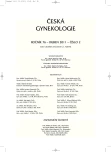A relation between the Polycystic Ovary Syndrome and the status of Ovarian Hyperstimulation Syndrome in IVF patients after controlled hyperstimulation
Authors:
Martina Moosová 1; J. Moos 2; V. Filová 3; J. Pavelková 1; R. Jarošová 1; K. Řežábek 1
Authors‘ workplace:
Centrum asistované reprodukce Apolinář (CAR), Gynekologicko-porodnická klinika 1. LF UK a VFN, Praha, přednosta prof. MUDr. A. Martan, DrSc.
1; Sigma-Aldrich, spol. s r. o., Praha
2; Immunotech, a. s., Praha
3
Published in:
Ceska Gynekol 2011; 76(2): 123-127
Overview
Objective:
Ovarian Hyperstimulation Syndrome (OHSS) is a severe health complication observed in some patients undergoing hormonal stimulation during IVF. Some authors [17] present that OHSS is associated with Polycystic Ovary (PCO) and with a high count of growing follicles (more than 18) responding to FSH hyperstimulation, although none of them is sufficient to predict the onset of OHSS. The aim of this study is to analyze the association between PCOS and OHSS the Inhibin B-based TFF/SBM index [13].
Design:
Retrospective analysis.
Setting:
Assisted Reproduction Center, Department of Obstetrics and Gynecology, 1st Faculty of Medicine, Charles University and General Faculty Hospital in Prague, Sigma-Aldrich, Prague, Immunotech, a.s., Prague.
Methods:
Serum and follicular fluid of 36 women (high responders with more than 18 growing follicles) in IVF program were collected at the day of oocyte pick up and used for analysis of Inhibin B. Age: mean 30.2 years (24–35 years, median 31.0 years ), BMI: mean 22.34 (18.3–29.7, median 21.6). For every patient, the TFF/SBM index was calculated as follows: [concentration in FF] x [growing follicle count]/ [concentration in serum] x [body mass]. A distribution of the following parameters were compared: OHSS status, TFF/SBM index based on Inhibin B, growing follicle count and the incidence of PCOS.
Results:
Values of the TFF/SBM index showed an association with the severe form of OHSS but not with the incidence of PCOS.
Conclusion:
These observations suggested that the incidence of PCOS is not associated with the development of severe form of OHSS, but may be still associated with a high count of growing follicles.
Key words:
OHSS, PCOS, inhibin B, IVF, follicular fluid, serum.
Sources
1. Aboulghar, MA., Mansour, RT. Ovarian hyperstimulation syndrome: classifications and critical analysis of preventive measures. Hum Reprod Update, 2003, 9, p. 275-289.
2. Asch, RH., Li, HP., Balmaceda, JP., et al. Severe ovarian hyperstimulation syndrome in assisted reproductive technology: definition of high risk groups. Hum Reprod, 1991, 6, p. 1395‑1399.
3. Badawy, A., Elnashar, A. Treatment options for polycystic ovary syndrome, review. International Journal of Women’s Health, 2011, 3, p. 25-35.
4. D’Angelo, A. Ovarian hyperstimulation syndrome prevention strategies: cryopreservation of all embryos. Semin Reprod Med, 2010, 28(6), p. 513-518.
5. Delbaere, A., Smits, G., De Leener, A., et al. Understanding ovarian hyperstimulstion syndrome. Endocrine, 2005, 26, p. 285‑290.
6. Delvinge, A. General definition of the ovarian hyperstimulation syndrome. In Ovarian Hyperstimulation Syndrome. Ed. Gerris, J., Delvinge, A. and Olivennes, F. United Kingdom: Informa Healthcare, 2006, p. 1-5.
7. Delvigne, A., Demoulin, A., Smitz, J., et al. The ovarian hyperstimulation syndrome in in vitro fertilization: a Belgian multicentric study. I. Clinical and biological features. Hum Reprod, 1993, 8, p. 1353-1360.
8. Ericsson, GF., Hsueh, AJ. Secretion of ”inhibin” by rat granulosa cells in vitro. Endocrinology, 1978, 103, p. 1960-1963.
9. Esinler, I., Bayar, U., Bozdag, G., Yarali, H. Outcome of intracytoplasmic sperm injection in patients with polycystic ovary syndrome or isolated polycystic ovaries. Fertil Steril, 2005, 84, p. 932-937.
10. Fanchin, R., Schonäuer, LM., Righini, C., et al. Serum anti-Müllerian hormone is more strongly related to ovarian follicular status than serum inhibin B, estradiol, FSH and LH on day 3. Hum Reprod, 2003, 18, p. 323-327.
11. Goldzieher, JW., Axelrod, LR. Clinical and biochemical features of polycystic ovarian disease. Fertil Steril, 1963, 14, p. 631–653.
12. Griesinger, G., Diedrich, K., Tarlatzis, BC., Kolibianakis, EM. GnRH-antagonists in ovarian stimulation for IVF in patients with poor response to gonadotrophins, polycystic ovary syndrome, and risk of ovarian hyperstimulation: a meta-analysis. Reprod Biomed Online, 2006, 13, p. 628-638.
13. Moos, J., Řežábek, K., Filova, V., et al. Comparison of follicular fluid and serum levels of Inhibin A and Inhibin B with calculated indices used as predictive markers of ovarian hyperstimulation syndrome in IVF patients. Reprod Biol Endocrinol, 2009, 7, p. 86.
14. Navot, D., Bergh, PA., Laufer, N. Ovarian hyperstimulation syndrome in novel reproductive technologies: prevention and treatment. Fertil Steril, 1992, 58, p. 249-261.
15. Rotterdam ESHRE/ASRM- Sponzored PCOS Consensus Workshop Group. Revised 2003 consensus on diagnostic criteria and long-term health risks related to polycystic ovary syndrome. Fertil Steril, 2004, 81(1), p. 19-25.
16. Swanton, A., Storey, L., McVeigh, E., Child, T. IVF outcome in women with PCOS, PCO and normal ovarian morphology. Eur J Obstet Gynecol Reprod Biol, 2010, 149, p. 68-71.
17. Tummon, I., Gavrilova-Jordan, L., Allemand, MC., Session, D. Polycystic ovaries and ovarian hyperstimulation syndrome: a systematic review. Acta Obstet Gynec Scand, 2005, 84(7), p. 611-616.
Labels
Paediatric gynaecology Gynaecology and obstetrics Reproduction medicineArticle was published in
Czech Gynaecology

2011 Issue 2
Most read in this issue
- Extended embryo culture in IVF does not improve pregnancy rate
- Uterine fibroids and their treatment
- Luteal support in the IVF/ET programme
- Decreased fertility and today’s possibility of examination in reproductive immunology
